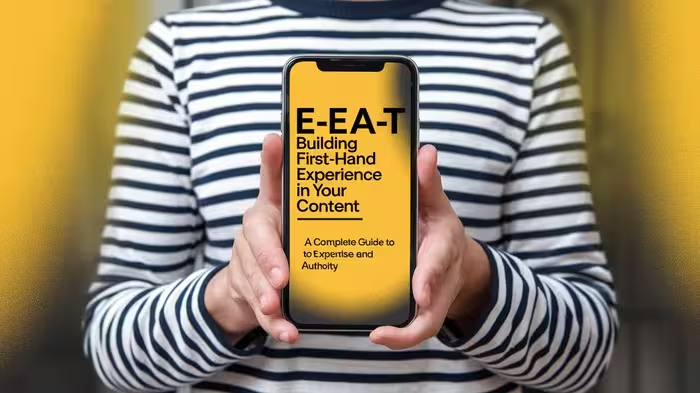Have you ever wondered why some content just feels more authentic and trustworthy than others? The secret lies in something called E-E-A-T, and I’m going to show you exactly how to master it.
As someone who’s been creating content for years, I’ll share real examples and practical tips that will help you transform your content from good to great.
Understanding E-E-A-T Fundamentals
What is E-E-A-T?
E-E-A-T stands for Experience, Expertise, Authority, and Trustworthiness. Think of it as your content’s report card that Google and your readers use to decide if they can trust what you’re saying. It’s like having a seal of approval that says, “Yes, this person really knows what they’re talking about!”
The Evolution from E-A-T to E-E-A-T
Remember when everyone was talking about E-A-T? Well, Google added another ‘E’ for Experience because they realized something important: real-life experience matters just as much as book smarts. It’s like the difference between learning to cook from a textbook versus spending years in a kitchen – both are valuable, but hands-on experience adds an extra layer of credibility.
Why Experience Matters in Content
Experience is like the secret sauce in your favorite recipe. It’s what makes your content unique and valuable. When you write from experience, you can:
- Share real problems and solutions you’ve encountered
- Offer practical tips that actually work
- Tell authentic stories that resonate with readers
- Provide insights that can’t be found in theory alone
The Four Pillars of E-E-A-T
Experience Explained
Experience is about “been there, done that.” It’s the difference between someone who’s read about mountain climbing and someone who’s actually climbed Mount Everest. Your first-hand experience might include:
- Projects you’ve completed
- Challenges you’ve overcome
- Results you’ve achieved
- Lessons you’ve learned the hard way
Expertise in Content
Expertise goes beyond just knowing facts – it’s about understanding the “why” behind the “what.” Show your expertise by:
- Explaining complex topics in simple terms
- Predicting industry trends based on deep knowledge
- Answering common questions before they’re asked
- Connecting different concepts in meaningful ways
Authority Building
Authority is like your reputation in the content world. Build it by:
- Getting recognized by industry experts
- Being featured in respected publications
- Earning relevant certifications
- Building a strong portfolio of work
Trustworthiness Signals
Trust is earned, not given. Include trust signals like:
- Accurate, up-to-date information
- Clear sources and references
- Transparent about your background
- Regular content updates
Incorporating First-Hand Experience
Personal Stories and Case Studies
Share your journey and results:
- Document your processes
- Show before-and-after scenarios
- Include specific metrics and outcomes
- Discuss both successes and failures
Practical Examples
Bring concepts to life with real examples:
- Step-by-step guides based on your experience
- Screenshots or visuals of your work
- Actual problems you’ve solved
- Real feedback from clients or users
Behind-the-Scenes Insights
Give readers a peek behind the curtain:
- Share your decision-making process
- Explain how you handle challenges
- Reveal industry insider tips
- Discuss common misconceptions
Creating Experience-Based Content
Research Methods
Build on your experience with solid research:
- Combine personal knowledge with data
- Validate your experiences with studies
- Compare your findings with others
- Stay updated with industry changes
Content Structure
Organize your content like a story:
- Start with a compelling hook
- Build up to key insights
- Include relevant examples
- End with actionable takeaways
Writing Techniques
Voice and Tone
Write like you’re talking to a friend:
- Use conversational language
- Share personal anecdotes
- Ask rhetorical questions
- Address the reader directly
Storytelling Elements
Make your content memorable:
- Create a narrative arc
- Use vivid descriptions
- Include emotional elements
- Build suspense and resolution
Demonstrating Expertise Through Content
Credibility Markers
Show why readers should trust you:
- List relevant experience
- Share professional achievements
- Include testimonials
- Link to your portfolio
Industry Knowledge
Prove you know your stuff:
- Discuss industry trends
- Analyze market changes
- Share insider insights
- Make informed predictions
Professional Background
Be transparent about your journey:
- Share your learning path
- Discuss your role and responsibilities
- Highlight key achievements
- Explain your specialty areas
Measuring E-E-A-T Success
Performance Metrics
Track these important numbers:
- Time on page
- Bounce rate
- Social shares
- Comment engagement
User Engagement
Look for these positive signals:
- Quality comments
- Social media mentions
- Email responses
- Content republishing requests
Search Rankings
Monitor your content’s performance:
- Keyword rankings
- Featured snippets
- Backlink quality
- Overall visibility
Conclusion
Building first-hand experience into your content isn’t just about following Google’s guidelines – it’s about creating genuine value for your readers. When you combine real experience with expertise, authority, and trustworthiness, you create content that truly resonates and stands the test of time. Remember, E-E-A-T isn’t a destination; it’s a journey of continuous learning and sharing.
Frequently Asked Questions
- How long does it take to build strong E-E-A-T signals?
Building E-E-A-T is an ongoing process, but you can start showing experience immediately by sharing your current knowledge and gradually building more authority over 6-12 months. - Can I write about topics where I have limited experience?
Yes, but be transparent about your level of experience and supplement your content with expert interviews, thorough research, and clear references to authoritative sources. - How do I demonstrate experience if I’m just starting in my field?
Document your learning journey, share your experiments and results, and focus on topics where you have hands-on experience, even if it’s limited. - Should I update old content to include more first-hand experience?
Absolutely! Regularly updating old content with new experiences and insights not only improves E-E-A-T but also keeps your content fresh and relevant. - How can I measure if my E-E-A-T is improving?
Look for indicators like increasing organic traffic, better engagement metrics, more backlinks from authoritative sites, and positive user feedback in comments and social shares.


